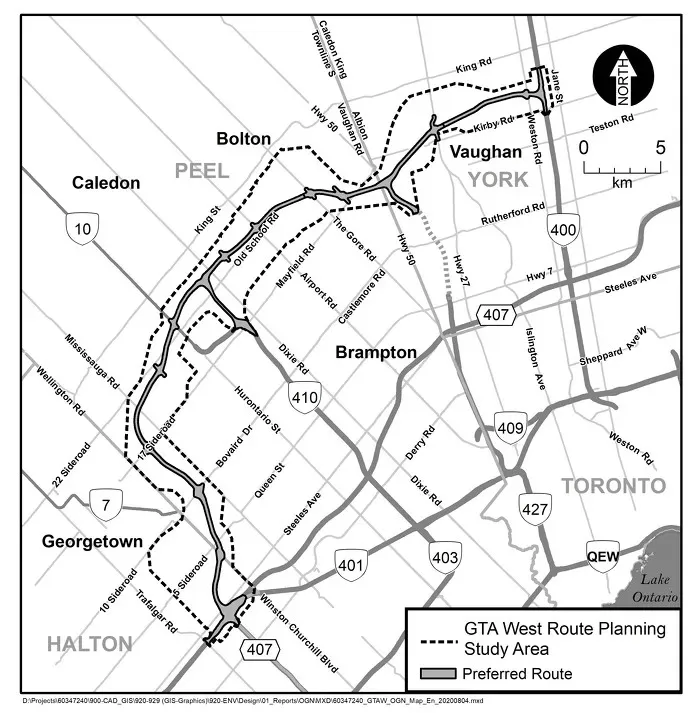A US$780 million eastward extension to Toronto’s major toll highway 407 has opened after four years of construction.
Work on 407 East Phase 1 project – which also included construction of the smaller Highway 412 – involved building more than 148 lane-kilometres and 11 interchanges.
The 22km road stretches from Brock Road in the town of Pickering to Harmony Road in the city of Oshawa. Highway 412 is a 10km north-south road that connects Highway 407 to Highway 401. Travel on the toll road will be free u
June 21, 2016
Read time: 3 mins
A US$780 million eastward extension to Toronto’s major toll highway 407 has opened after four years of construction.
Work on 407 East Phase 1 project – which also included construction of the smaller Highway 412 – involved building more than 148 lane-kilometres and 11 interchanges.
The 22km road stretches from Brock Road in the town of Pickering to Harmony Road in the city of Oshawa. Highway 412 is a 10km north-south road that connects Highway 407 to Highway 401. Travel on the toll road will be free until the end of the year.
407 East Development Group (407EDG) was selected by the Ontario Ministry of Transportation and Infrastructure Ontario in 2012 to design, build, finance and maintain Highway 407 East Phase 1. The consortium’s key members include930 Cintra Infraestructuras and 2482 SNC Lavalin.
The majority of the work was done by local contractors. Asphalt, steel, concrete and other materials required for the project were sourced from local firms.
“No one was allowed onto the construction site without undergoing extensive safety and environmental protection training and orientation,” according to a statement from 407EDG. “There were no serious injuries and the Lost Time Injury Rate on the project was 90% lower than the Ontario [provincial] construction industry rate. 407EDG achieved the Certificate of Recognition (COR) for its safety record, which is the Ontario construction standard, and successfully maintained it throughout the project.”
“We are particularly proud of our safety record on this project,” said Steve Hankins, chief executive of 407EDG.
407EDG is responsible for maintenance, including snow removal, for the next 30 years. To maintain the highway, 22 full-time employees have been hired and will work from a new maintenance facility. Local contractors will be hired on an as-needed basis.
Work continues on restoration of more than 147 hectares of forest, meadow and wetland, including the planting of 650,000 native trees and shrubs, all supported by locally sourced native wildflower and grass seed.
407 East Phase 1 was developed using Infrastructure Ontario’s Alternative Financing and Procurement (AFP) model. The Ministry of Transportation established the scope and purpose of the project and the work was financed and carried out by 407EDG. Once the project was completed according to contract, only then did 407EDG receive payment from the province.
A statement from 407EDG said that the AFP model allows large, complex infrastructure projects to be delivered faster and more efficiently - at a lower, long term net cost - than traditional procurement. It also “protects taxpayers from cost overruns and transfers project risks to the partner who has the expertise, experience and ability to handle that risk best”.
Work on 407 East Phase 1 project – which also included construction of the smaller Highway 412 – involved building more than 148 lane-kilometres and 11 interchanges.
The 22km road stretches from Brock Road in the town of Pickering to Harmony Road in the city of Oshawa. Highway 412 is a 10km north-south road that connects Highway 407 to Highway 401. Travel on the toll road will be free until the end of the year.
407 East Development Group (407EDG) was selected by the Ontario Ministry of Transportation and Infrastructure Ontario in 2012 to design, build, finance and maintain Highway 407 East Phase 1. The consortium’s key members include
The majority of the work was done by local contractors. Asphalt, steel, concrete and other materials required for the project were sourced from local firms.
“No one was allowed onto the construction site without undergoing extensive safety and environmental protection training and orientation,” according to a statement from 407EDG. “There were no serious injuries and the Lost Time Injury Rate on the project was 90% lower than the Ontario [provincial] construction industry rate. 407EDG achieved the Certificate of Recognition (COR) for its safety record, which is the Ontario construction standard, and successfully maintained it throughout the project.”
“We are particularly proud of our safety record on this project,” said Steve Hankins, chief executive of 407EDG.
407EDG is responsible for maintenance, including snow removal, for the next 30 years. To maintain the highway, 22 full-time employees have been hired and will work from a new maintenance facility. Local contractors will be hired on an as-needed basis.
Work continues on restoration of more than 147 hectares of forest, meadow and wetland, including the planting of 650,000 native trees and shrubs, all supported by locally sourced native wildflower and grass seed.
407 East Phase 1 was developed using Infrastructure Ontario’s Alternative Financing and Procurement (AFP) model. The Ministry of Transportation established the scope and purpose of the project and the work was financed and carried out by 407EDG. Once the project was completed according to contract, only then did 407EDG receive payment from the province.
A statement from 407EDG said that the AFP model allows large, complex infrastructure projects to be delivered faster and more efficiently - at a lower, long term net cost - than traditional procurement. It also “protects taxpayers from cost overruns and transfers project risks to the partner who has the expertise, experience and ability to handle that risk best”.







